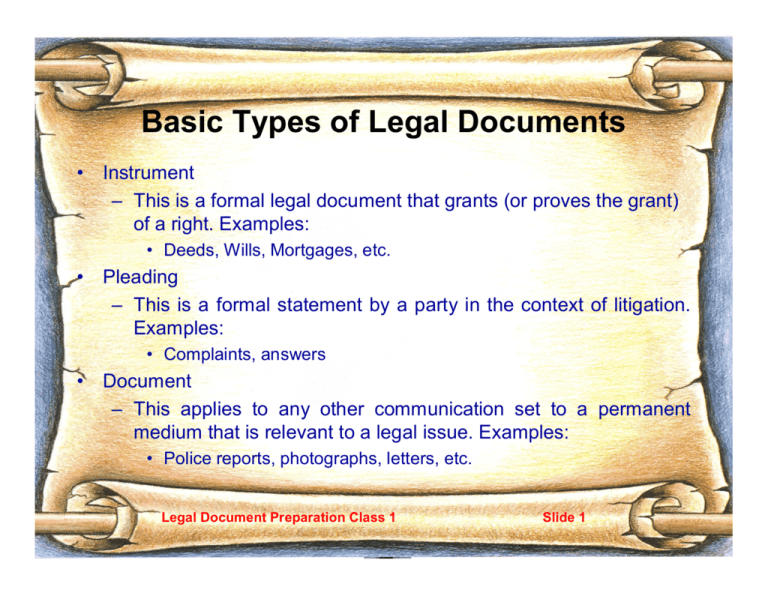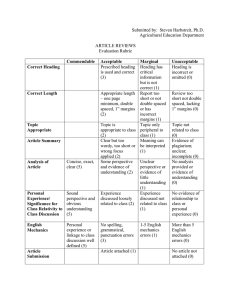Legal Document Preparation: Types & Components
advertisement

Basic Types of Legal Documents • Instrument – This is a formal legal document that grants (or proves the grant) of a right. Examples: • Deeds, Wills, Mortgages, etc. • Pleading – This is a formal statement by a party in the context of litigation. Examples: • Complaints, answers • Document – This applies to any other communication set to a permanent medium that is relevant to a legal issue. Examples: • Police reports, photographs, letters, etc. Legal Document Preparation Class 1 Slide 1 Types of Legal Instruments • Contract – Any written agreement can fall under this heading • Deed – This transfers any interest in real estate • Including easements, mortgages, etc. • Business Documents • Article of incorporation, bylaws, partnership agreements • Will/ Codicil – These are special legal documents that allow gifts to be given after one’s death • Trust – Establishes an agreement whereby the trustee agrees to hold property for the beneficiary Legal Document Preparation Class 1 Slide 2 Obtaining Background Information • Preparation and execution of any legal task requires, at its threshold, certain information from the clients. This can be obtained at an interview and/or through a questionnaire. This information includes: – Family information – Financial information and which other advisors the client is working with – Employment information – Health information – Important documents relevant to the client – (If a civil action) All information and documentation relevant to the case Legal Document Preparation Class 1 Slide 3 Where to Get Forms • Very few documents are drafted from scratch. Almost all documents are drafted from templates belonging to the firm or accessed elsewhere. • A big part of drafting many forms is locating appropriate templates. There can be gotten from: – Documents done for previous clients – Commercial forms producers, such as: • American Jurisprudence Legal Forms • West Legal Forms • Online sources Legal Document Preparation Class 1 Slide 4 General Form of Legal Writings • For the most part, you can choose your own type of paper, ink, etc. However, for certain instruments and in papers submitted to a court, there are often rules regarding these things, which must be followed. • Court that have such rules often publish them in a circular that can be obtained from the court. • Always ask the clerk when in doubt! Legal Document Preparation Class 1 Slide 5 Some physical aspects to Legal Documents • Paper – Use letter size in general; legal size is sometimes used as well and may be required for certain types of instruments such as deeds • Typeface – Use a conservative, traditional font • Margins – Make sure to use margins big enough to make reading comfortable; such as 1­1.5 inch margins • Spacing – Pleadings and some instruments should be double spaced – Most other documents can be 1.5 spaced – Letters are often single spaced Legal Document Preparation Class 1 Slide 6 Special Components of Legal Documents • In addition to the body of the document, legal documents often must contain: – Caption (for anything submitted to the court) – Heading (for most legal documents, including letters, etc.) – Place for signatures, especially for instruments – Acknowledgment/ space for the document to be notarized, where appropriate – Filings with the court often must also have space for the attorney to sign as well Legal Document Preparation Class 1 Slide 7 Special Mechanical Rules for Legal Documents • The following are often put in ALL CAPS: – Names of people or businesses, organizations, etc. – Title of the instrument – Header words of important paragraphs (e.g., “WHEREAS”) • Grammar and spelling – Correct grammar and spelling are important not only to avoid changing the meaning of the document, but also to present an aura of professionalism • Numbers are often written in both English and Arabic numbers; e.g., – Ten thousand Dollars ($10,000) • Page numbering – The first page is not numbered; all subsequent pages are numbered at the bottom center. Legal Document Preparation Class 1 Slide 8 Pre­Printed Forms • Sometimes, courts or other agencies will have specific forms that they will require for certain tasks. To use such forms: – Some may be available in Word (or similar) format. There can be filled in easily on your computer. • Sometimes, courts require affidavits that you did not change anything substantive about the form so that the clerk does not have to read through the entire form – If you cannot secure these forms in Word (or similar) format, the best thing is to fill it in with a typewriter, though very neat print writing is usually also accepted. • Inserting “N/A” or “0” is preferable to leaving the space blank. Legal Document Preparation Class 1 Slide 9











